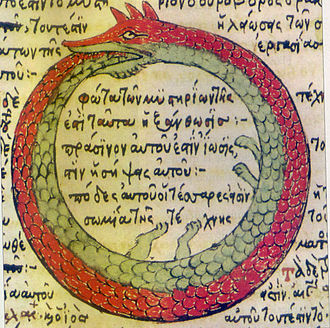Teli

Teli (Hebrew: תלי "curled" ?), the dragon of the world, the serpent of heaven, is, according to the Sefer Yetzirah, the supreme ruler of the created world; the zodiac and the heart are subordinate to him.
„The dragon in the world is like a king on his throne. The zodiac in the year is like a king in the kingdom. The heart in man is like a king in war.“
In the Sefer ha-Bahir it states:
„Rabbi Berechjā sat and recited: What is [the] "Teli"? This is a form that is before God, as it is said (Cant. Cantic. 5:11), "His locks are curled." And what is [the] "galgal" (the heavenly sphere)? It is the belly. And what is [the] heart? That of which it is said[1] "to the heart of heaven"[2], and in it are contained the 32 hidden ways of the Chokhma[3].“
A similar role is played in the Gnostic teachings of the Ophites by the Leviathan, who, as the Ouroboros serpent, coils around the lower world of the seven planetary spheres, ruling them as king and permeating them as the world soul.
The origin and meaning of the word teli[5] is uncertain. It occurs only once in the Tanakh, in Gen 27:3 EU, where it refers to an unspecified hunting tool. In the medieval commentaries on the Sefer Yetzirah, teli is understood as a serpent or dragon. Thus Shabbtai Donnolo writes:
„And who is the teli? When God created the firmament above us, which is divided into seven heavens, he created the teli of water and of fire in the form of a great tannin (Hebrew תנינ, sea monster) (Genesis 1:21), like a great coiled serpent, and made him head and tail, and stretched him out in the fourth[6] heaven [...]. And all the planets and the lights and the constellations are attached to him. And he is appointed (as) king over all, to guide them, whether for good or for evil.“ (Lit.: quoted from Herrmann, p. 272)
The dragon thus surrounds the visible world where the crystal sky is to be found, where the finite spatial world merges into the infinite supra-spatial world. According to the phonetic inventory, Teli means the "impact (T) of the living (L) spirit, the divine I (J)". One may also think here of the symbol of the Ouroboros, the snake biting its tail, sometimes also represented in the form of one or two dragons, whereby one half of the animal is usually light-coloured and the other dark-coloured, thus indicating that the opposites unite in it, such as good and evil, male and female, and so on. By turning back into itself, it is at the same time a symbol of eternity.
A similar conception is found in the 2nd century among the Gnostic sect of the Ophites (from Greek: ὄφις Ophis "serpent") , where Leviathan, who is also called the soul of all things here, winds around the lower realm of the seven planetary spheres.
Literature
- Klaus Herrmann (editor), Sefer Jezira - Buch der Schöpfung., Verlag der Weltreligionen, Frankfurt a. M. und Leipzig, 2008, ISBN 978-3-458-70007-4
- Gershom Scholem: Ursprung und Anfänge der Kabbala, Walter de Gruyter Verlag, Berlin, New York 2001
- Gershom Scholem: Sefer ha-Bahir - Das Buch Bahir: Ein Schriftdenkmal aus der Frühzeit der Kabbala, 2. Auflage, Aurinia Verlag 2016, ISBN 978-3937392158
References
- ↑ Deuteronomy 4:11
- ↑ The tenth sefira
- ↑ The 32 paths of wisdom described in the Sefer Yetzirah
- ↑ Schoelm 2016, p. 77
- ↑ Gershom Scholem writes: "Teli, understood in the early Middle Ages as the constellation of the dragon, is the Syriac athalia, "stella quae solem tegens eclipsim efficit", according to Payne-Smith I , 423. In this sense it already occurs in the Manichean Book of Psalms, ed. Allberry, fasc. II, p. 196. This usage corresponds exactly to that in the undoubtedly very old astronomical 'Baraitba of Samuel', and goes back to Assyrian atalû, as already proved by A. E. Harkavy in Ben 'Ammi, vol. I (1887), pp. 27-86. When the Teli moves its head and tail as a "sky serpent" or dragon, it thereby causes the eclipses." (Lit.: Scholem, p. 67)
- ↑ Possibly a reference to Atziluth, the highest of the Four Worlds, which corresponds to the Devachan.
